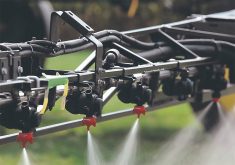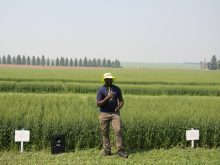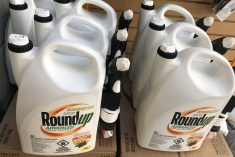Glacier FarmMedia – This isn’t going to be one of those springs where you can stroll into your local ag retailer and then walk out with everything you need.
The list of products facing supply issues is long, and growing longer — herbicides, fertilizer, parts, certain feeds and even ear tags.
“Our message is simple: Do what is agronomically right by planning ahead and have discussions with your retailers earlier than normal,” said Cornie Thiessen, general manager of ADAMA Agricultural Solutions Canada.
And you may want to widen your circle of suppliers, he added.
“Farmers will need to be careful here,” he said. “Someone may take their order and even their money, but will they be able to fulfil an order? Suppliers may not be able to get product to retailers, and subsequently to farmers, in time.”
Glyphosate is among the products of concern after Bayer warned last month that one of its suppliers had a “force majeure” event that would disrupt shipments of Roundup for up to three months.
Ray Redfern placed his orders earlier than usual and hopes they will all arrive in time.
“I’m going to be optimistic for the moment that we will find a balance that looks after most of our customers,” said the president of Redferns Farm Service in Brandon, Man.
But glyphosate isn’t the only worry. He pointed to products that include methylcyclopropene (MCP) in the mix, saying some companies have capped orders on some items.
“We’ll have some products that we won’t get enough of to handle the demand if the demand is normal, or especially if it was increased due to the plant populations,” he said.
Producers may well have to spend more time looking for alternate products to achieve the same chemistry, he said — something that puts more emphasis on the relationship between farmers and their retailer.
“We expect to have to be able to spend more time to be able to understand what products would work, and to try and give growers alternatives to the one that they may have chosen to use themselves.”
Unlike fertilizer, however, stocking up early on herbicide is a less viable solution.
Crop protection should be based on actual weed plant populations and scouting in the field, and is therefore a shorter-term decision made in season, Redfern stressed.
He echoed the message put out annually by provincial weed specialists, who urge producers to scout early, when the plants are small and easier to control.
“This would be a year to try and make sure that you do all of those things to mitigate the weed population,” Redfern said.
Part of the fertilizer issue is that prices have shot up so high.
“If you want to lock in a price, we need more than just to say, ‘I’d like it in the spring,’” he said. “We need to have a commitment and in most cases it’s either a percentage or its purchase price. There’s a significant number of growers who didn’t have the biggest crop last year and so cash flow and availability of cash is limited.”
‘At the mercy of the freight system’
Supply chain issues are also showing up at the parts counter.
“My biggest concern is if you have issues at seeding time and are unable to source parts,” said Bill Campbell, president of the Keystone Agricultural Producers, Manitoba’s main farm group.
“If they are 10 days out or on back order, what do you do for seeding if it’s your tractor or air seeder? These are huge concerns.”
The issue is two pronged — getting products made and getting them delivered, said Dean Iwanchysko, general manager of Hepson Equipment in Brandon.
“You’re at the mercy of the freight system, which is pretty damaged right now,” he said. “Things from the States, across Canada, Europe, anywhere, everything is a lot slower than it used to be. Just getting the actual components built by the manufacturers that build them, that’s been a challenge too.”
He, too is worried. He called the situation “extremely concerning,” adding parts are often taking one to three weeks longer to get in.
“We’re actually trying to stock up extra on the pieces that we normally do sell,” Iwanchysko said. “In the past, you would do your regular stock and then as it starts to dwindle down, you start to reorder, just to keep it replenished.”
Now, however, the company will likely increase that restocking order by 25 per cent to build a cushion for popular items, he said.
Producers should also consider stocking up on high-wear items.
“Don’t just rely on, ‘Oh, I’ll just swing by the dealer and get it.’ Plan for the year,” he said.
But that’s easier said than done.
“Going into seeding, you don’t know what’s going to break until it breaks,” Campbell said. “I don’t think that we can keep an inventory of everything that we may need on the farm. Logistics are going to play a part in this.
“Hopefully there’s a trouble-free seeding season, but we all know that when you use equipment, it breaks.”
Everyday items are an issue
Even products you’d never give a second thought to could be a problem.
Ear tag manufacturers are also having issues because of both a lack of raw material and higher absenteeism caused by COVID-19, said the Canadian Cattle Identification Agency.
The agency said that its distributor was receiving shipments “periodically.”
“But as the busy calving season is upon us, demand is exceeding availability for some products,” it said in a statement.
“It’s not just one thing; it’s many things,” said general manager Anne Brunet-Burgess.
She noted that two manufacturers used by the agency are located in Texas, where shipments were delayed due to atypical winter weather, she said.
The agency has introduced a cap on order sizes for some tags.
However, there are enough tags available for producers, although they may not get their preferred option, said Brunet-Burgess.
“There’s no reason why someone would not be compliant in moving animals without tags,” she said. “But it may require to look in different places and, again, just by popularity, some brands have run out or are back ordered.”
One supplier in Manitoba’s Interlake region said his workload has gone way up.
“For the storefront, we don’t know what’s coming,” said Roger Mangin of Inwood Feed and Supply. “Some of the most common things that should not be on back order, are on back order.”
Ear tag supplies are also an issue for hog farmers, but not the only one.
There have been delays in getting live animals shipped to the U.S., along with shortages of soybean meal from south of the border, said Cam Dahl, general manager of the Manitoba Pork Council.
“Some of this is pandemic related, and I would put things like the ear tags in that category as this is the impact of the pandemic on general supply chains,” said Dahl. “And then some of this is ongoing, endemic supply issues that have been made worse by pandemic-related issues.”
There have been similar problems sourcing feed additives like lysine, he added, noting an ongoing shortage of truckers is a major cause.
– Alexis Stockford is a reporter for the Manitoba Co-operator. Her article appeared in the Mar. 17, 2022 issue.
















